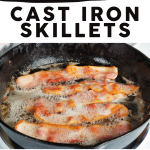Tips and tricks to easily cook bacon in your cast iron skillet without sticking, burning, or hard to clean up messes!

I've been cooking almost exclusively (except eggs) in my cast iron pan for over a year. While I may still be a novice compared to people who have been using their cast iron pans for 30 years, I've really learned a lot over the last year, including how to cook bacon without it sticking or being hard to clean up after. And yes, I learned the hard way a couple of times. You're talking about bacon that burned so bad I had to take the whole pan outside in the yard to keep it from setting off the fire alarm. My four-year-old told that story to anyone who would listen for a week. (Let's be honest, he was partially to blame for that catastrophe, but I digress.)
Nowadays, bacon is one of my favorite things to cook in the cast iron pan because I feel like it helps to keep it seasoned without me actually having to re-season it. Essentially, it's good for the pan and my taste buds. And please, for the love, don't come at me about a Dietitian who shouldn't eat bacon while you chow down on your bowl of sugar and chemical-filled cereal. Nutrition is never black and white. It's on a scale. Choose whole, unprocessed foods most of the time; the rest should be mindful in moderation. We tend to eat uncured bacon 2-4 times a month in our house.
Now, onto cooking your bacon in your beloved cast iron pan. These tips should save you some of the pain I endured while on the learning curve of cooking bacon in my cast iron skillet.
What kind of bacon should you cook in a cast iron pan?
Whatever kind you want. I used to think only thick cut would be able to stand up to the cast iron pan, but now I regularly cook all kinds - even paper-thin bacon. It can be done if you follow the tips below! We prefer no sugar or nitrates added bacon, but that has to do with health concerns and nothing to do with the pan.
Tip 1: Start with a well-seasoned cold pan.
Don't attempt to cook anything, much less bacon, in a pan that needs seasoning. You will be annoyed, frustrated, and disappointed from start to finish. You can read all about how I season my cast iron pan here.
You'll want to start with a cold pan because the fat will melt slowly from the bacon, creating a layer of oil preventing it from sticking to the pan. This is honestly the most important tip I could share with you. Do this, and you'll be off to a good start!
Tip 2: Keep the heat low, and don't be afraid to remove the pan from the heat while cooking.
I have an electric stove (not by choice). The highest I ever turn my cast iron pan on is 3 out of 10. Cast iron takes a while to heat up, but then it holds the heat REALLY well (sometimes too well for my electric stove top) and evenly. I often find myself toggling between turning it off completely and back to 1 when I'm cooking multiple batches of bacon. I don't usually have to remove the pan from the heat, but I do often have to turn the burner off occasionally during cooking. You'll know your pan is too hot if the bacon starts cooking unevenly (cooking faster in some places and uncooked in others) or sticking. Cooking a cast iron on an electric oven to a temp level of 1-2 is the equivalent of a nonstick or ceramic, even at 4-5, or maybe even higher.
Tip 3: Don't drain the liquid between batches.
Frying bacon essentially is frying it in its own fat. You are almost deep frying it, but not quite. If you want to drain the fat while cooking, I suggest using a George Foreman or some other method of cooking, like a nonstick pan. But for your cast iron, don't drain anything, or you may get sticky bacon.
Tip 4: Use a bacon screen and long tongs.
Cooking bacon is known to "pop," and the way cast iron holds heat, you're bound to have some splatter. A splatter screen and long tongs to help flip it will go a long way.
Tip 5: Know when to flip bacon and take off the heat.
Honestly, this is less of a "cast iron" tip and more of a general bacon cooking tip. Nothing will teach you how to cook bacon perfectly other than experience. And perfect also depends on the audience. Some people like uber crunchy bacon, and others like it really chewy. Learning to tell when the point is that you should flip your bacon and/or remove it from the stove to make it the perfect texture is an art in and of itself. In general, for chewy bacon, I look for it to start to become a golden brown color where the white fat marbling once was. Then I know it's time, but again I firmly believe it's an art that can only be perfected with time and practice. Remember, you want to remove the bacon from the pan immediately once you think you've reached perfection. Otherwise, the bacon will keep cooking (even in a pan that has been removed from the heat, see tip 2.)
Tip 6: Clean the pan while hot!
When you are done cooking, drain that fat (soak it up in a paper towel or pour it into a glass jar and let it harden, then throw it away or keep it or whatever.) Take that hot pan over to the sink and run some hot water over it. Hot water + a hot pan, + a cast iron scrubber brush should be all you need. (See tips to clean a cast iron pan here.)






Leave a Reply